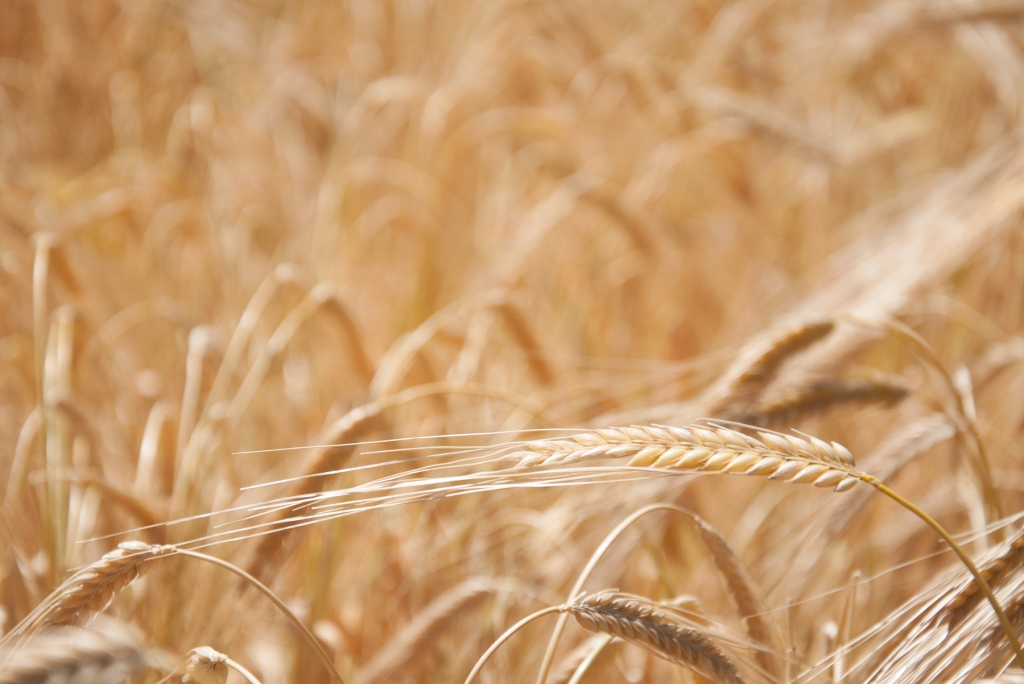
Most people who know me understand the love I have for bread; kneading the dough, watching yeast come to life, and finally eating it, as-is or with a nice butter or soft cheese. Wheat supports a unique alchemy; the grain’s gluten structure and starches allow microbial life (yeasts) to grow, making bread and other products possible.

Wheat has a different protein content and make-up, depending on the variety of the grain and the time of year when it is planted. This is where “cake and pastry flour” “bread flour” and “all purpose flour” come in. Pastry flour is “soft flour”, meaning it has a low protein content – it will not develop gluten in the same way which bread (hard) flour will. Gluten proteins are responsible for the structure of dough – think of it like an elastic or balloon. The stretchier it is (as in bread dough), the more bubbles it can hold, the chewier it is etc. All-purpose flour is like a jack-of-all-trades, meaning that most pastries will still be fairly delicate and breads will have enough protein to develop.

Recently I spent the day shooting photos for my colleague Joy Jones from Made For You by Madeleine Bakery. (Joy is an exciting person to talk to for anyone passionate about food, baking and baking theory and her baked goods are delightful.) She has a unique bakery, where everything is produced from whole grain that is milled on site. She described the hands-on differences between hard and soft wheat – before and after grinding. It’s amazing to feel the variations which affect the baking process! (Using whole grains adds other variables to the baking process: Since pieces of the bran are left intact, they can actually cut away at the gluten structure of your bread dough, if overworked. Whole wheat flour also requires more moisture than white flour.) There are many benefits of using whole grains, mainly nutrition content and flavour, due to most or all three parts of the wheat grain (bran, germ, endosperm) being used.

Once you add liquid to a wheat-based dough, the gluten development process begins. When making delicate products like cakes, pastries, or cookies, you want to minimize how much you “work” the dough after liquid is added. For bread, this is when you want to start kneading to start developing those elastic qualities. You know when you have worked bread dough enough by doing the “windowpane test”: take a piece of your dough and stretch it, holding it up to the light. If it stretches without tearing, you are ready to let the yeast do it’s work.
As yeast feeds on available starches (sugars) in dough, it is fermenting and producing byproducts which will flavour the bread, and carbon dioxide bubbles which supply the texture.
The inner texture of bread, known as the crumb, is created by the activity of the yeast and the hands-on work of the baker. From how you handle the bread throughout fermentation to the final moments of the yeast’s life in the oven, your dough is a living, breathing creature.
When I made the above bread (recipe from Saveur, here) it was a long fermentation process. As I pre-heated the oven, I joked with Elvir that I felt how NASA must feel before a launch (it sounds melodramatic, but I’m easily excited). Before baking, you know what you want to happen and you have tried to follow the necessary steps to make it reality: but at this point it’s all faith.
Within a couple of minutes in the oven, the dough had sprung off of the pan, defying gravity. It’s called oven spring for a reason! Exposed to warm temperatures, the yeast goes into overdrive eating as much as it can and expelling carbon dioxide bubbles before dying. Depending on how the gluten structure has developed, the bread will hold these bubbles in varying ways. Flavours that have been developing throughout fermentation come out, and new flavour compounds are created by maillard reactions: the browning of proteins on the top of bread doughs. (These are the same reactions responsible for making charred/seared meat so flavourful.)

Baking is truly a delicious science experiment and an act of mindfulness – connecting with the dough, your hands and the world around you. (Flour temperature, water temperature, room temperature and relative humidity are all possible “controls” to start nerding about when baking.) Finally, as the bread comes out of the oven, you can savour the magical flavours and textures created by human cooperation with the natural world.


Much of what I know about wheat composition and baking theory was taught to me by Tim Simpson from Ambrosia Pastry, while I was at George Brown College. Ambrosia, run by Tim Simpson and Aura Hertzog, produces fantastic bean-to-bar chocolate (which you can order online) and is open every Saturday selling pastries from their storefront.
Some helpful resources for learning about bread are King Arthur Flour, Northwest Sourdough for Sourdough tips, and The Bread Baker’s Guild of America. There are many fantastic books out there: honourable mentions are The Tartine Series of books by Chad Robertson, Bread Baker’s Apprentice by Peter Reinhart, Bien Cuit: The Art of Bread by Zachary Golpert.
Want more foodundercontrol between posts? Follow me on social media for more photos and behind-the-scenes thoughts!
instagram.com/lncharman
twitter.com/truffleandthyme
facebook.com/foodundercontrol




Leave a comment